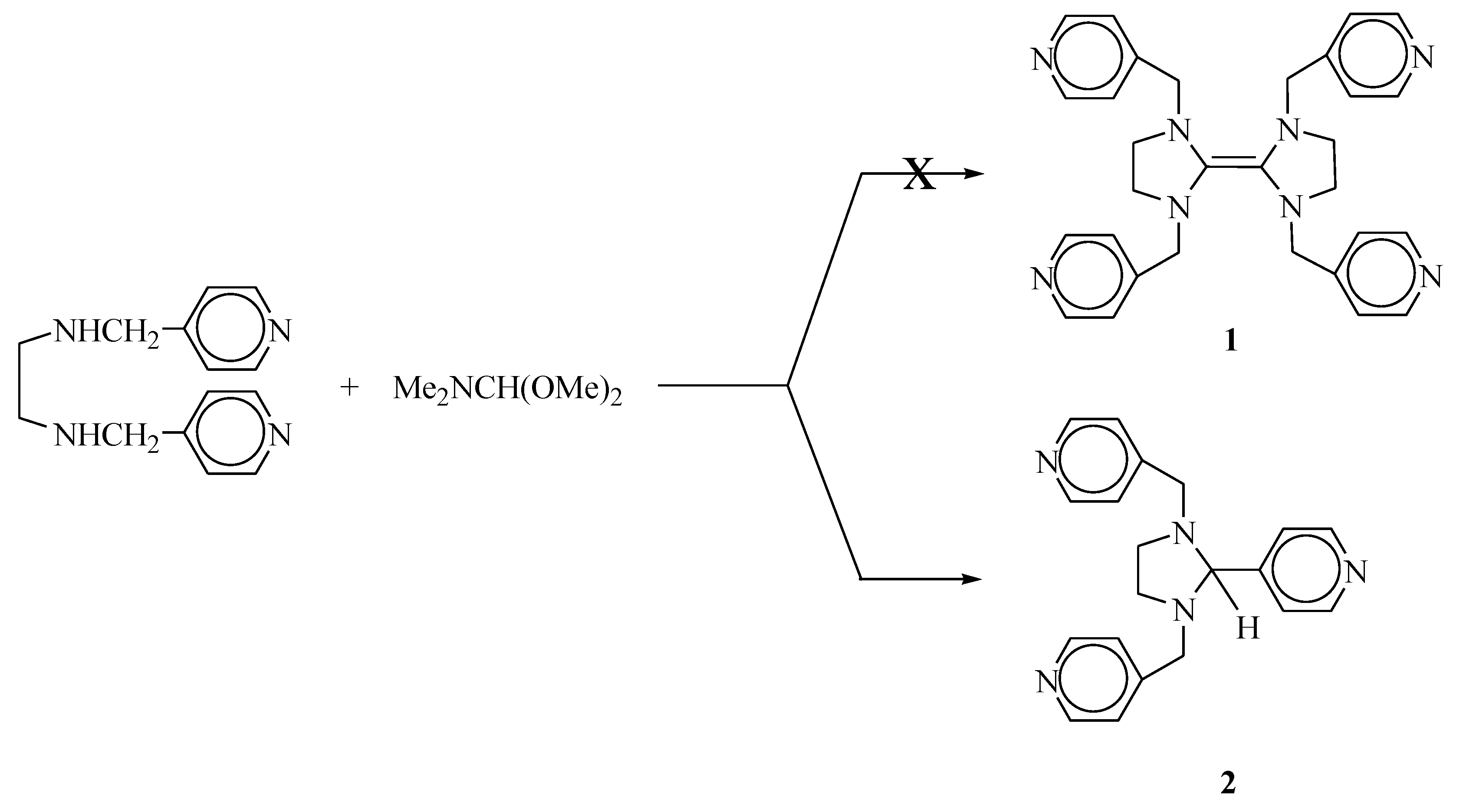2-(4-Pyridyl)-1,3-di(4-picolyl)imidazolidine
Abstract
:Introduction
Experimental
Synthesis of 2-(4-pyridyl)-1,3-di(4-picolyl)imidazolidine (2)
Supplementary materials
Supplementary File 1Supplementary File 2Supplementary File 3References
- Hoffman, R.W. Reactions of electron-rich olefins. Angew. Chem. Int. Ed. 1968, 7, 754–765. [Google Scholar] [CrossRef]
- Wiberg, N. Tetraaminoethylenes as strong electron donors. Angew. Chem. Int. Ed. 1968, 7, 766–779. [Google Scholar] [CrossRef]
- Bock, H.; Borrmann, H.; Havlas, Z.; Oberhammer, H.; Ruppert, K.; Simon, A. Structures of sterically overcrowded and chargeperturbed molecules. 12. tetrakis(dimethylamino) ethene an extremely electron-rich molecule with unusual structure both in the crystal and in the gas-phase. Angew. Chem. Int. Ed. Engl. 1991, 30, 1678–1681. [Google Scholar] [CrossRef]
- Cardin, D.J.; Çetinkaya, B.; Lappert, M.F.; Muir, L.J.M.; Muir, K.W. An electron-rich olefin as a source of co-ordinated carbene; Synthesis of trans-PtCl2[C(NPhCH2)2]PEt3. Chem. Commun. 1971, 400–401. [Google Scholar] [CrossRef]
- Cardin, D.J.; Çetinkaya, B.; Çetinkaya, E.; Lappert, M.F.; Muir, L.J.M.; Muir, K.W. Trans-/cis-Isomerism and isomerisation of Pd(II) and Pt(II) carben complexes. J. Organomet. Chem. 1972, 44, C59–62. [Google Scholar] [CrossRef]
- Wanzlick, H.; Schikora, E. Ein nucleophiles Carben. Chem. Ber. 1961, 94, 2389–2393. [Google Scholar] [CrossRef]
- Lappert, M.F.; Maskell, R.K. A new class of benzoin condensation catalyst, the bis-(1,3-dialkylimidazolidin-2-ylidenes). J. Chem. Soc., Chem. Commun. 1982, 580–581. [Google Scholar]
- Çetinkaya, B.; Demir, S.; Özdemir, İ.; Toupet, L.; Semeril, D.; Bruneau, C.; Dixneuf, P.H. First rutnenium complexes with a chelating arene carbene ligand as catalytic precursors for alkene metathesis and cycloisomerisation. New J. Chem. 2001, 25, 519–521. [Google Scholar]
- Yiğit, M.; Yiğit, B.; Özdemir, İ.; Çetinkaya, E.; Çetinkaya, B. Active ruthenium-(N-Heterocyclic Carbene) complexes for hydrogenation of ketones. Appl. Organometal. Chem. 2006, 20, 322–327. [Google Scholar] [CrossRef]
- Lappert, M.F.; Maskell, R.K. Carbene-transition-metal complexes as hydrosilylation catalysts. J. Organomet. Chem. 1984, 264, 217–228. [Google Scholar] [CrossRef]
- Winberg, H.E.; Carnahan, J.E.; Coffman, D.D.; Brown, M. Tetraaminoethylenes. J. Am. Chem. Soc. 1965, 87, 2055–2056. [Google Scholar] [CrossRef]
- Çetinkaya, E.; Hitchcock, P.B.; Jasim, H.A.; Lappert, M.F.; Sypropoulos, K. Synthesis and characterisation of unusual tetraaminoalkenes (Enetetramines). J. Chem. Soc., Perkin Trans. 1 1992, 561. [Google Scholar]
- Boldwin, J.E.; Walker, J.A. Competing [1,3]- and [3,3]-sigmatropic rearrangements of electron-rich olefins. J. Am. Chem. Soc. 1974, 96, 596–597. [Google Scholar] [CrossRef]
- Chamizo, J.A.; Lappert, M.F. [3,3]- and [1,3]-Sigmatropic amino-Claisen rearrangements of electron-rich alkenes. J. Org. Chem. 1989, 54, 4684–4686. [Google Scholar] [CrossRef]

© 2010 by the authors; licensee Molecular Diversity Preservation International, Basel, Switzerland. This article is an open-access article distributed under the terms and conditions of the Creative Commons Attribution license (http://creativecommons.org/licenses/by/3.0/).
Share and Cite
Yiğit, B.; Yiğit, M.; Özdemir, İ.; Çetinkaya, B.; Çetinkaya, E. 2-(4-Pyridyl)-1,3-di(4-picolyl)imidazolidine. Molbank 2010, 2010, M649. https://doi.org/10.3390/M649
Yiğit B, Yiğit M, Özdemir İ, Çetinkaya B, Çetinkaya E. 2-(4-Pyridyl)-1,3-di(4-picolyl)imidazolidine. Molbank. 2010; 2010(1):M649. https://doi.org/10.3390/M649
Chicago/Turabian StyleYiğit, Beyhan, Murat Yiğit, İsmail Özdemir, Bekir Çetinkaya, and Engin Çetinkaya. 2010. "2-(4-Pyridyl)-1,3-di(4-picolyl)imidazolidine" Molbank 2010, no. 1: M649. https://doi.org/10.3390/M649



